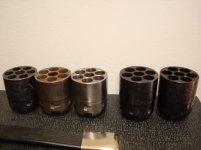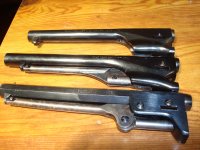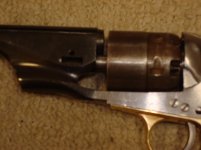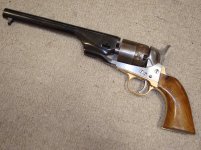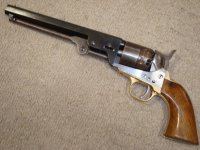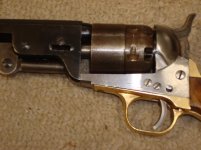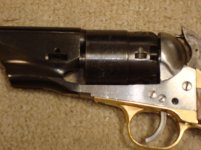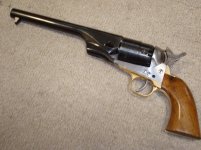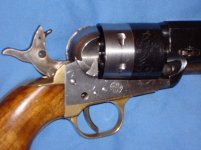CaptainCrossman
Moderator
ok here goes- I have an 1851 Navy and an 1860 Army- according to the historical information, the original Colt 1860 Army had a slightly longer cylinder than an 1851 Navy- and therefore the forcing cone on the 1860 barrel was shortened.
comparing my Armi San Paolo 1851 to the Pietta 1860, this is true- the 1860 has a longer cylinder, and shorter forcing cone on barrel, than the 1851
yet I have (2) spare 1860 Army 44 cal. rebated cylinders, for import replicas- that are the same length as the Navy cylinders. These are old cylinders, who knows what brand they are- they aren't original vintage Colts
problem- these cylinders won't work as "spares" on my 1860 Army, there is a huge gap about 1/8" between the cylinder and barrel forcing cone. They are also useless for the 1851 Navy, wrong caliber- although the length does match the Navy gun forcing cone and they mate up/revolve properly on that gun
the cylinders are too short- the only way they would work is if I had an 1851 Navy barrel, and it was bored out to .451" for 44 cal slugs. Then the forcing cone would be long enough to mate to these spare cylinders
has anyone else had this problem ?
these cylinders obviously came off of one of those 1851 Navy hybrids, that are 44 caliber- the historically inaccurate replicas. In their quest to cut costs, they must have been boring the Navy 36 barrels out to 44 caliber, and boring the Navy 36 cal. cylinders out to 44 caliber, to make cheap/quick 44's out of Navy 36 cal parts- instead of tooling up and making the proper length barrels/cylinders that were historically accurate
comparing my Armi San Paolo 1851 to the Pietta 1860, this is true- the 1860 has a longer cylinder, and shorter forcing cone on barrel, than the 1851
yet I have (2) spare 1860 Army 44 cal. rebated cylinders, for import replicas- that are the same length as the Navy cylinders. These are old cylinders, who knows what brand they are- they aren't original vintage Colts
problem- these cylinders won't work as "spares" on my 1860 Army, there is a huge gap about 1/8" between the cylinder and barrel forcing cone. They are also useless for the 1851 Navy, wrong caliber- although the length does match the Navy gun forcing cone and they mate up/revolve properly on that gun
the cylinders are too short- the only way they would work is if I had an 1851 Navy barrel, and it was bored out to .451" for 44 cal slugs. Then the forcing cone would be long enough to mate to these spare cylinders
has anyone else had this problem ?
these cylinders obviously came off of one of those 1851 Navy hybrids, that are 44 caliber- the historically inaccurate replicas. In their quest to cut costs, they must have been boring the Navy 36 barrels out to 44 caliber, and boring the Navy 36 cal. cylinders out to 44 caliber, to make cheap/quick 44's out of Navy 36 cal parts- instead of tooling up and making the proper length barrels/cylinders that were historically accurate
Last edited:


